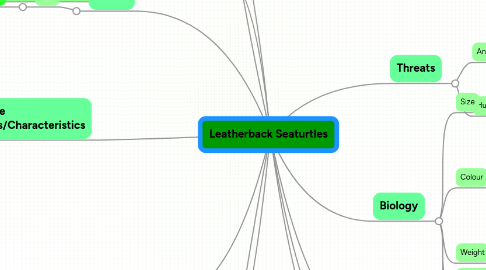
1. Action Plan
1.1. What I can do...
1.1.1. Attend a nesting beach clean-up
1.1.2. Raise awarness with a school project to the class
1.2. What NGO's Can do...
1.2.1. Raise awreness with billboards
1.2.2. arrange beach clean-ups
1.2.3. adopt a turtle
1.2.4. arrange public Seaturtle walks
1.3. What the Government can do...
1.3.1. Put up signs where leatherback seaturtles live and nest saying "Leatherback seaturtle nesting area, be aware, do not disturb or litter."
1.4. What is Being done...
1.4.1. Listed as Endangered in 1970
1.4.1.1. This made it illegal to
1.4.1.1.1. Kill a Leatherback seaturtle
1.4.1.1.2. Take eggs from their nests
1.4.2. The Convention on International Trade of Endangered Species (CITIES) forbids trade of any seaturtle products on the international trade market
2. Habitat
2.1. Temperature
2.1.1. Can go down to 6°C
2.2. Water
2.2.1. Saltwater
3. Map of Range
4. Resources
4.1. Websites
4.1.1. www.hww.ca
4.1.2. http://www.nmfs.noaa.gov/pr/pdfs/education/kids_times_turtle_leatherback.pdf
4.1.3. http://www.tpwd.state.tx.us/huntwild/wild/species/endang/animals/reptiles_amphibians/lethback.phtml
4.2. Books
4.2.1. The Leatherback Turtle: Sea Turtles and Their Conservation By: Peter J. Morgan
5. Range
5.1. Northernmost
5.1.1. 71°N
5.2. Southernmost
5.2.1. 27°S
6. Status
6.1. END
6.1.1. Endangered
7. Diet
7.1. Eat soft-bodied creatures and plants
7.1.1. Jellyfish
7.1.2. Scalps
7.1.3. Tunicates
7.1.4. Squid
7.1.5. Fish
7.1.6. Crustaeans
7.1.7. Algae
7.1.8. Floating Seaweed
8. Unique Habits/Characteristics
8.1. Possible that it has enough capacity ro generate own body warmth even though a ectotherm(cold-blooded animal)
8.1.1. Body temperature can be as much as 18°C warmer than surrounding water
8.2. Combination of adaptions let's them survive in water much too cold for other marine animals
8.2.1. Dark colour
8.2.2. Thick layer of fat
8.2.3. High Volume-to-surface-area-ratio
8.3. Never developed ability to swim backward
8.4. Never been successfully raised to maturiaty in captivity
8.5. Male turtles never return to land after hatching
8.5.1. Collecting information about males must take place at sea
9. Threats
9.1. Animals(non-human)
9.1.1. Sharks
9.1.1.1. By hunting/eating
9.1.2. Killer Whales
9.1.2.1. By hunting/eating
9.1.3. Jaguars
9.1.3.1. By hunting/eating
9.2. Humans
9.2.1. Use nesting beaches and sites as recreational areas.
10. Biology
10.1. Size
10.1.1. Up to 2 meters long
10.2. Colour
10.2.1. Main Colour
10.2.1.1. Dark Bluish Black
10.2.2. Upper Shell
10.2.2.1. Dark bluish black with white or bluish white blotches
10.2.3. Body
10.2.3.1. Main colour with spots on land, looks brown when under water
10.2.4. Lower Shell
10.2.4.1. Pinkish-White
10.3. Weight
10.3.1. Up to 900 kg
10.4. Offspring
10.4.1. Female lays about 85-100 eggs
10.5. Life Cycle
10.5.1. At least 30 years up to 50 years or more
11. Biome
11.1. Oceans
11.1.1. Boreal
11.1.1.1. Scavange for food
11.1.2. Temperate
11.1.2.1. Scavange for food
11.1.3. Tropical
11.1.3.1. Nest
